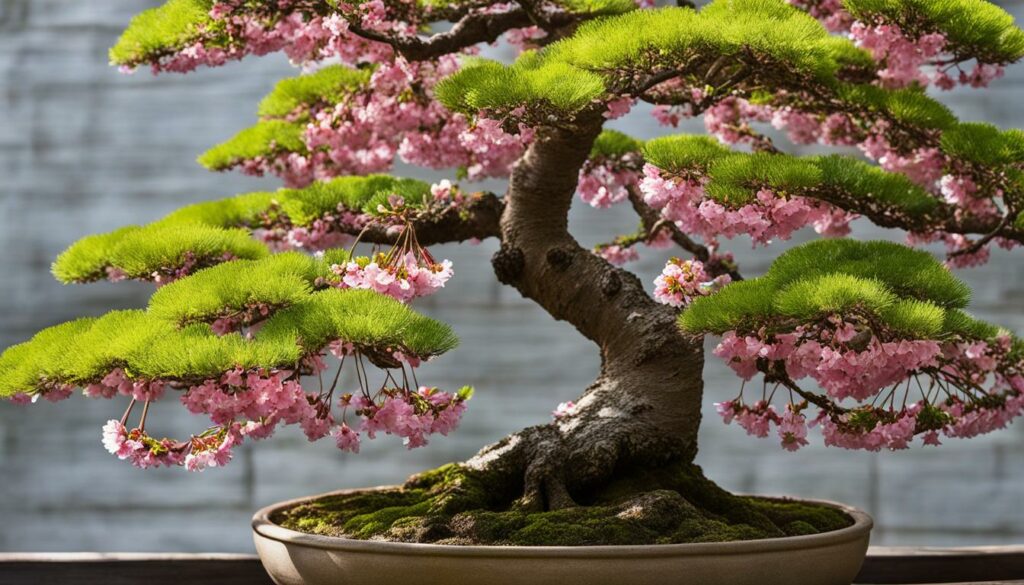Welcome to our comprehensive guide on Bonsai Tree Species Cherry Prunus – one of the most beloved varieties of flowering bonsai trees. Whether you are a seasoned bonsai enthusiast or just starting your journey, this guide will equip you with everything you need to know to cultivate these enchanting miniature trees. From its stunning blossoms to its unique care requirements, we’ll explore each aspect of Cherry Prunus bonsai so that you can start growing your own and enjoy its vibrant beauty.
Key Takeaways
- Cherry Prunus is a popular species of flowering tree that’s often used for bonsai cultivation.
- Cherry Prunus bonsai trees are admired for their striking beauty when in bloom and are treasured among bonsai enthusiasts.
- Proper care, such as optimal growing conditions and training techniques, is essential to ensure the health and longevity of your Cherry Prunus bonsai tree.
- Regular pruning, repotting, and pest prevention measures are necessary to maintain the vigor and beauty of your bonsai tree.
- Growing and nurturing a Cherry Prunus bonsai tree can be a rewarding and fulfilling experience, providing joy and satisfaction to its caretaker.
What is Cherry Prunus?
Before you start growing a Cherry Prunus bonsai, it’s essential to understand what Cherry Prunus is. Cherry Prunus is a species of flowering tree that belongs to the Rosaceae family. Also known as Prunus serrulata, this beautiful tree is cherished for its stunning blossoms and is a popular choice among bonsai enthusiasts. Native to Japan, Korea, and China, Cherry Prunus has become a beloved species worldwide.
The tree can grow up to 26 feet in height, but bonsai cultivators limit its growth and transform it into a miniature form, showcasing its beauty in a compact size. In the spring, the tree produces delicate pink or white flowers that add a beautiful touch to any garden or indoor space. Some Cherry Prunus cultivars have double-flowering blooms, while others bloom in darker shades of pink.
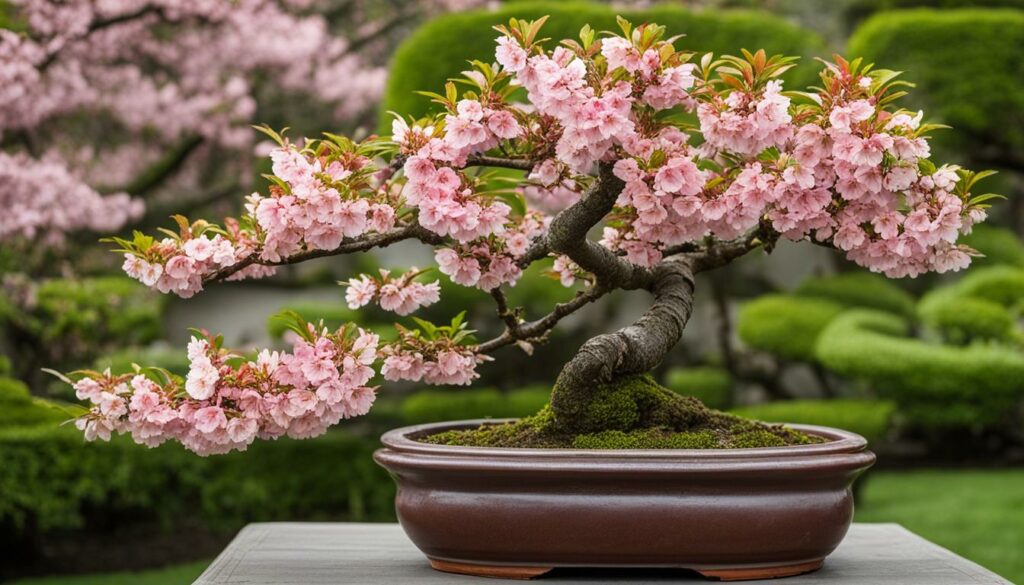
So why do enthusiasts prefer Cherry Prunus for bonsai cultivation? The answer is simple – its flowers! Bonsai growers love Cherry Prunus for the beautiful, delicate, and fragrant blossoms it produces. These blossoms symbolize beauty, love, and the temporary nature of life. Hence, they add a fascinating touch to any bonsai collection.
Cherry Prunus in Culture
“The Sakura flower symbolizes Japan’s culture of beauty, grace, and sensitivity” – Prime Minister Shinzo Abe
Cherry Prunus holds a significant cultural value, especially in Japan. The country celebrates the blooming of Cherry Prunus trees every spring, known as Hanami. People gather under the Cherry Prunus trees to appreciate their beauty, have picnics, and enjoy the moment. Additionally, the flowers of the Cherry Prunus tree are also essential in Japanese art, literature, and poetry.
The Beauty of Cherry Prunus Bonsai
Cherry Prunus bonsai trees are a stunning addition to any plant collection, treasured for their striking beauty when in bloom. Flowering bonsai trees display delicate pink or white flowers that cover the branches, creating a mesmerizing display that symbolizes beauty, love, and the transient nature of life. The captivating essence of Cherry Prunus bonsai trees makes them a must-have for any bonsai enthusiast.
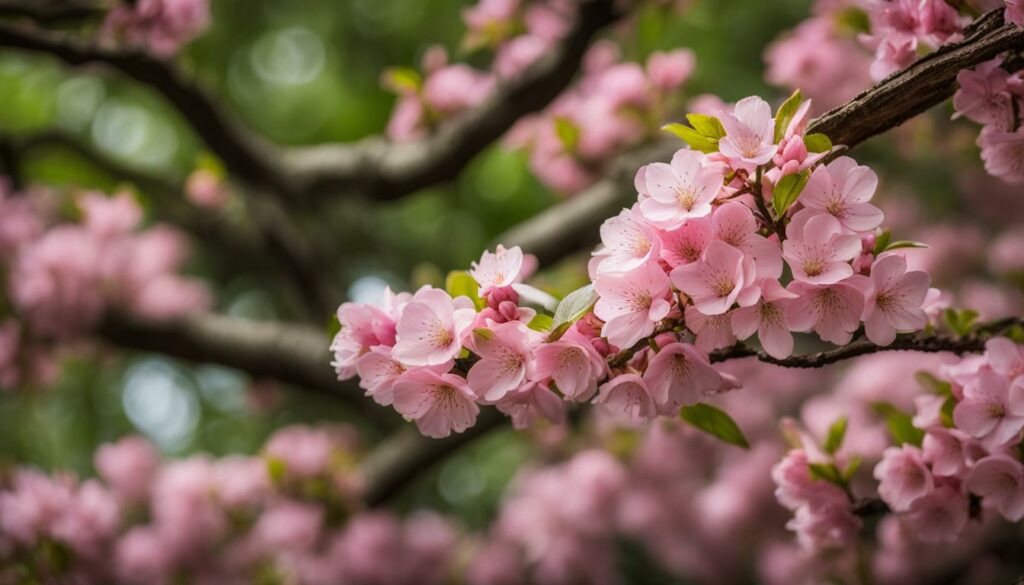
To recreate the beauty of nature, many bonsai growers choose to shape their Cherry Prunus bonsai trees to resemble miniature versions of full-sized trees. The art of growing and training a Cherry Prunus bonsai takes time, dedication, and patience, but the reward of watching your bonsai thrive and bloom is a deeply satisfying experience.
Choosing the Right Cherry Prunus Cultivar
Choosing the right Cherry Prunus cultivar for your bonsai requires careful consideration of factors such as size, growth habits, and desired flower color. Some of the most popular Cherry Prunus bonsai species include the Kanzan Cherry, Weeping Cherry, and Fuji Cherry.
The Kanzan Cherry is a robust and vigorous cultivar known for its pink double blossoms that open in early spring. With a height of up to 30 feet, it is an ideal choice for larger bonsai trees.
The Weeping Cherry cultivar, also known as the Pendula, is a stunning and elegant bonsai with a cascading growth habit. Its graceful branches create a serene and tranquil ambiance, making it perfect for outdoor displays.
The Fuji Cherry, also known as the Hill Cherry, is a dwarf and compact cultivar that produces delicate pink blooms in early spring. With a height of only 2 to 4 feet, it is an excellent choice for smaller bonsai trees and indoor displays.
| Cherry Prunus Bonsai Species | Height | Growth Habits | Flower Color |
|---|---|---|---|
| Kanzan Cherry | Up to 30 feet | Vigorous | Pink |
| Weeping Cherry | Varies | Cascading | Pink or White |
| Fuji Cherry | 2-4 feet | Dwarf | Pink |
Consider the size and location you intend to display your Cherry Prunus bonsai when choosing the right cultivar. Remember, the cultivars mentioned above are just a few of the many Cherry Prunus bonsai trees available and each has its unique characteristics. It’s essential to research extensively before making your final decision.
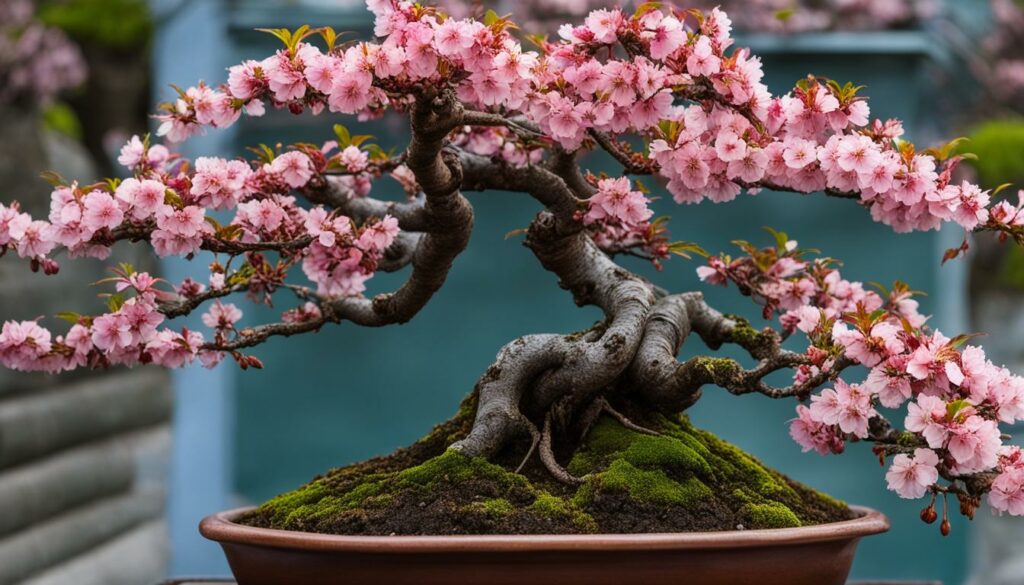
Growing Conditions for Cherry Prunus Bonsai
Ensuring the optimal growing conditions for your Cherry Prunus bonsai is crucial for its overall health and vitality. Here are some important factors to consider:
Temperature
The ideal temperature range for Cherry Prunus bonsai growth is between 60 and 70 degrees Fahrenheit. Extreme temperature fluctuations can harm the tree, so avoid placing it in areas with drafts or rapid temperature changes.
Light Requirements
Cherry Prunus bonsai require bright, indirect light. Place your bonsai in a location that receives at least six hours of sunlight but avoid exposing it to direct sunlight, which can scorch the leaves.
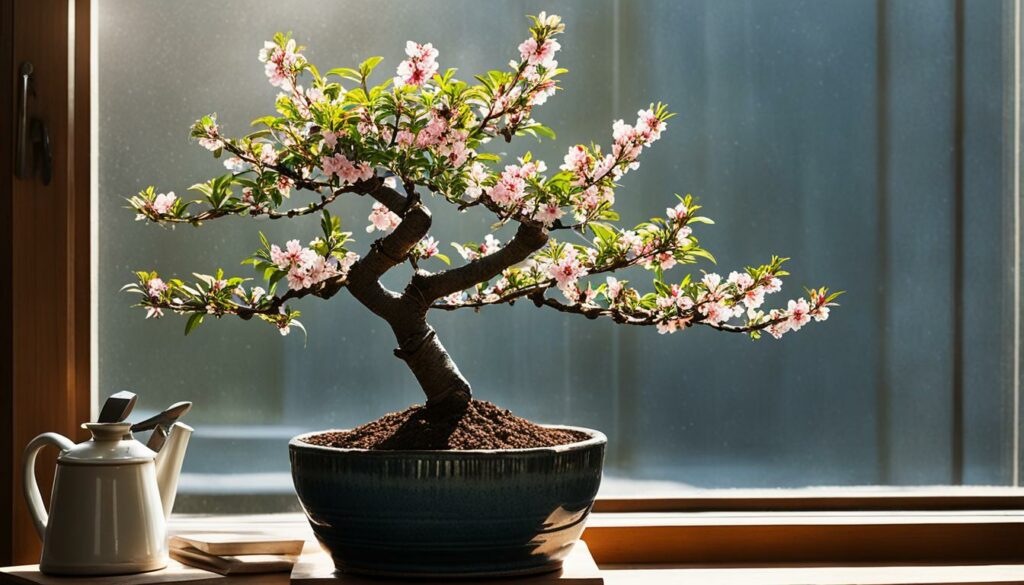
Soil Composition
Cherry Prunus bonsai require well-draining soil that provides ample moisture and nutrients. A recommended soil mix is a combination of akadama, pumice, and lava rock. Avoid using garden soil, which is too dense and retains too much moisture.
Watering and Fertilizing
Cherry Prunus bonsai require consistent moisture in their soil but avoid overwatering, which can lead to root rot. Water your bonsai when the topsoil is dry. Fertilize your bonsai once a month during the growing season. Use a balanced fertilizer, alternating between organic and chemical options.
Humidity
Cherry Prunus bonsai thrive in moderate to high humidity. To increase humidity levels, you can place a tray filled with water near your bonsai or use a humidifier in the room where it’s located.
Training Techniques for Cherry Prunus Bonsai
Proper training techniques are essential in transforming your Cherry Prunus bonsai into a stunning masterpiece. Below are some tips on how to shape and prune your bonsai tree:
Wiring Your Bonsai
Wiring is a technique used to control the direction of the branches of your bonsai tree. It involves wrapping copper or aluminum wire around the branches and trunk and bending them into the desired shape. When wiring your Cherry Prunus bonsai, use only enough pressure to bend the branches slightly, to avoid damaging them. The best time to wire your bonsai is during the growing season, typically in spring or early summer.
Pruning Your Bonsai
Pruning your bonsai involves cutting off branches to control its shape and size. The best time to prune your Cherry Prunus bonsai is in early spring before the buds start to form or after the tree has finished blooming. When pruning, use sharp, sterile pruning shears and make clean cuts at a slight angle to promote healing. Be careful not to remove too much foliage, as this can weaken your bonsai.
Branch Placement
The placement of the branches can help create the desired shape and form for your Cherry Prunus bonsai. Use wire to shape the branches and position them at the desired angle. Make sure to leave enough space between branches to allow light and air to penetrate to the lower branches. It’s important to regularly monitor your bonsai and adjust its branch position as necessary.
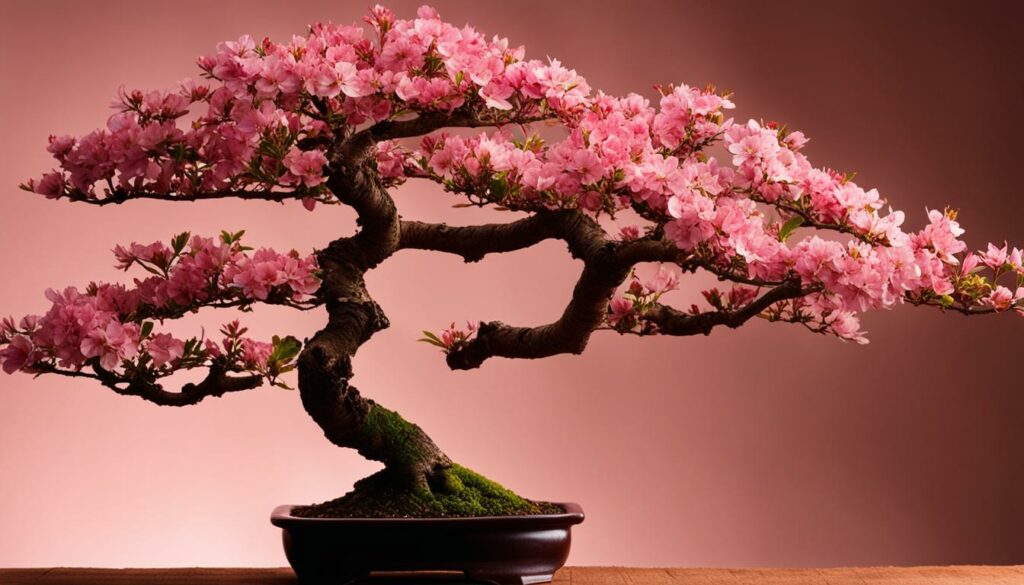
Pruning and Repotting Cherry Prunus Bonsai
To maintain the health and vigor of your Cherry Prunus bonsai, regular pruning and repotting are crucial. Pruning your bonsai tree promotes growth and flowering, while repotting ensures it has enough space for healthy root growth and fresh nutrients.
Start by pruning your Cherry Prunus bonsai in the early spring before new growth appears. Use shears to trim back any dead or damaged branches, as well as any branches that detract from the desired shape. Remember to cut at an angle and avoid leaving any stubs.
Additionally, you may want to prune new shoots and the tree’s canopy to encourage a bushier shape and more abundant blooms. However, be careful not to over-prune, as this can weaken the tree and undermine its health.
As for repotting, Cherry Prunus bonsai should be repotted every two to three years, ideally in the early spring. This process involves gently removing the tree from its pot, pruning back any excess roots, and settling it into a new pot with fresh potting mix. Use a well-draining, slightly acidic soil mix to ensure healthy root development.
Remember, Cherry Prunus bonsai are delicate trees and require gentle, attentive care. Regular pruning and repotting will help ensure that your bonsai remains healthy and vibrant for years to come.
Pruning and Repotting Checklist:
- Prune in early spring before new growth appears
- Trim back dead or damaged branches
- Cut at an angle and avoid leaving stubs
- Repot every two to three years, ideally in the early spring
- Gently remove the tree from its pot
- Prune back any excess roots
- Settle the tree into a new pot with fresh potting mix
- Use a well-draining, slightly acidic soil mix
Preventing Pests and Diseases in Cherry Prunus Bonsai
Protecting your Cherry Prunus bonsai from pests and diseases is essential to ensure its health and longevity. Here are some common pests and diseases that can affect your bonsai:
| Pests | Diseases |
|---|---|
| Spider mites | Root rot |
| Aphids | Leaf spot |
| Caterpillars | Brown rot |
To prevent infestation, regularly inspect your bonsai tree for signs of pests, such as holes in leaves, webs, or discoloration. If pests are detected, isolate the tree immediately and take steps to eradicate them before they spread to other plants. You may use natural remedies like neem oil or insecticidal soap to control small infestations. For severe cases, consult a professional.
To prevent the onset of diseases, ensure that your bonsai is receiving sufficient light, water, and nutrients. Avoid overwatering, as this can lead to root rot. When repotting, use new soil to prevent the spread of fungus or bacteria. Additionally, prune your bonsai regularly to promote airflow and limit the growth of mold and mildew.
Remember, prevention is key when it comes to pest and disease control. Consistent care and attention to detail will help keep your Cherry Prunus bonsai thriving.
Displaying and Appreciating Cherry Prunus Bonsai
Once you have nurtured your Cherry Prunus bonsai to perfection, it’s time to display it in all its beauty. A harmonious display can enhance the charm of your bonsai and add serenity to any space. You can choose to showcase your bonsai indoors or outdoors, depending on the weather conditions and the size of your bonsai tree.
If you plan to display your bonsai indoors, placing it near a well-lit window can provide the optimal light conditions. Moreover, choosing an appropriate pot and stand can add a touch of elegance to your Cherry Prunus bonsai display. Alternatively, you can also display your bonsai outdoors on a patio or balcony, highlighting its natural beauty.
Creating a harmonious display enhances the aesthetic appeal of your bonsai and emphasizes its significance as an art form. Appreciating the value of bonsai cultivation is essential to truly savor the beauty of the Cherry Prunus bonsai. Taking time to observe the intricate details of your bonsai tree, the delicacy of its flowers, and the harmony of its overall form can bring a sense of peace and tranquility, enriching your life in countless ways.
A beautiful cherry Prunus bonsai display, showcasing the delicate flowers and harmonious form of the bonsai tree.
Cherry Prunus Bonsai Troubleshooting
Despite your best efforts, your Cherry Prunus bonsai might have some problems. Here are a few common bonsai tree problems and troubleshooting tips.
Yellowing Leaves
If you notice yellowing leaves on your Cherry Prunus bonsai, it could be due to overwatering, underwatering, or nutrient deficiencies. Check the soil moisture levels and adjust your watering schedule as needed. Consider fertilizing your bonsai with a balanced fertilizer to provide vital nutrients for healthy growth.
Lack of Flowering
If your Cherry Prunus bonsai fails to flower, insufficient light may be the culprit. Ensure that your bonsai is getting adequate light, ideally between six and eight hours per day, while avoiding direct sunlight. If light is not the issue, consider repotting your bonsai and adjusting the soil’s pH levels to promote blooming.
Root Rot
Root rot, caused by excessive watering, is a common issue for Cherry Prunus bonsai trees. Make sure your bonsai’s soil is well-draining and avoid leaving your bonsai sitting in standing water. If root rot has set in, inspect the roots and remove any decayed or mushy parts before repotting in fresh soil.
Tip: Regularly inspecting your Cherry Prunus bonsai for signs of problems can help prevent bigger issues from occurring and ensure a healthy, long-lived bonsai tree.
Remember, identifying and addressing problems early on is crucial for maintaining the health and vitality of your Cherry Prunus bonsai. With proper care and troubleshooting, you can enjoy the breathtaking beauty of your bonsai tree for years to come.
The Joy of Cherry Prunus Bonsai
Cultivating Cherry Prunus bonsai is a gratifying pursuit that brings immense joy and a sense of fulfillment. Witnessing the transformation of a humble sapling into a stunning, blooming work of art is an experience unlike any other.
Your Cherry Prunus bonsai is a testament to your patience, dedication, and hard work, and it can provide a source of tranquility and relaxation as you tend to its needs. Taking care of your bonsai tree is a meditative process that allows you to connect with nature and appreciate the beauty of the world around you.
The rewards of growing a Cherry Prunus bonsai are plentiful. You’ll witness the tree’s beauty in its blossoms and foliage, and the process of caring for your bonsai can help you develop new skills and an appreciation for the art of bonsai. It can also be a source of inspiration and creativity, as you exercise your imagination and artistic instincts to shape and style your bonsai into a unique masterpiece.
In addition to the pride and satisfaction that comes from growing a healthy and vibrant Cherry Prunus bonsai, you’ll also be able to pass on this tradition to future generations. Sharing the joy of bonsai with others, whether it’s through teaching, gifting, or simply admiring your tree, is a rewarding experience that can bring you closer to those around you.
In conclusion, the joy of growing Cherry Prunus bonsai is immeasurable. From the beauty of the blossoms to the satisfaction of cultivating a living work of art, there are countless rewards to be gained from this timeless tradition. So take the plunge and start your own bonsai journey today – you won’t regret it!
FAQ
What is Cherry Prunus?
Cherry Prunus, also known as Prunus serrulata, is a species of flowering tree that belongs to the Rosaceae family. It is cherished for its stunning blossoms and is a popular choice among bonsai enthusiasts.
Why are Cherry Prunus bonsai trees treasured?
Cherry Prunus bonsai trees are treasured for their striking beauty when in bloom. Delicate pink or white flowers cover the branches, creating a mesmerizing display. These miniature trees symbolize beauty, love, and the transient nature of life, making them a captivating addition to any bonsai collection.
How do I choose the right Cherry Prunus cultivar for bonsai?
It’s essential to select a Cherry Prunus cultivar that is suitable for bonsai cultivation, considering factors such as size, growth habits, and desired flower color. We’ll explore different Cherry Prunus varieties and guide you in choosing the right one for your bonsai.
What are the ideal growing conditions for Cherry Prunus bonsai?
Creating the optimal growing conditions is vital for the health and vitality of your Cherry Prunus bonsai. We’ll discuss the ideal temperature, light requirements, soil composition, as well as watering and fertilizing techniques to ensure your bonsai thrives in its new environment.
How do I train my Cherry Prunus bonsai?
To achieve the desired shape and form, proper training techniques are essential for your Cherry Prunus bonsai. We’ll delve into the art of wiring, pruning, and branch placement, guiding you through the steps to transform your bonsai into a masterpiece.
When and how should I prune and repot my Cherry Prunus bonsai?
Regular pruning and repotting are crucial to maintain the health and vigor of your Cherry Prunus bonsai. We’ll discuss when and how to prune your bonsai tree to promote growth and flowering. Additionally, we’ll guide you through the process of repotting and selecting the appropriate potting mix.
How can I prevent pests and diseases in my Cherry Prunus bonsai?
Like any other plant, Cherry Prunus bonsai trees are susceptible to pests and diseases. We’ll highlight common pests and diseases that can affect your bonsai and provide tips on prevention, identification, and treatment, ensuring your bonsai remains in optimal health.
How should I display and appreciate my Cherry Prunus bonsai?
Displaying your Cherry Prunus bonsai properly enhances its beauty and adds serenity to any space. We’ll explore different display options, such as indoor and outdoor arrangements, and provide tips on creating a harmonious bonsai display. Additionally, we’ll discuss the significance of appreciating the art of bonsai.
What should I do if I encounter issues with my Cherry Prunus bonsai?
Even with proper care, issues may arise with your Cherry Prunus bonsai. We’ll address common problems such as yellowing leaves, lack of flowering, and root rot, and offer troubleshooting tips to help you overcome these challenges and ensure the longevity of your bonsai tree.
What are the rewards of growing a Cherry Prunus bonsai?
Growing and nurturing a Cherry Prunus bonsai is a rewarding experience that brings joy and a sense of accomplishment. We’ll discuss the satisfaction of watching your bonsai thrive, the joy of witnessing its stunning blooms, and the deep connection that can be formed with these elegant miniature trees.
